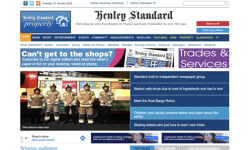Faced with the choice between an email-free holiday and the high probability of divorce, this summer I opted to turn my Blackberry off and put it in a drawer before heading for the sun.
It proved to be the right choice on so many levels, not least of which was the overwhelming absence of any multi-million pound contracts that I thought I might have missed. On my return, the inbox was disappointingly almost entirely jammed with the usual reams of spam mail - but also a host of postings from LinkedIn discussion groups that I joined in a burst of enthusiasm some 18 months ago. Most of these were immediately deleted, unread, causing no immediate or discernible damage to my commercial prospects or professional competence.
Although LinkedIn has pretty much become the default “Facebook for suits” and boasts around 70 million users on a worldwide basis, the reality of B2B engagement with social networking sites is a very far cry from the stellar success of Facebook and YouTube in the consumer realm. Many of the specialist groups and sub-groups which have sprung up on LinkedIn in recent years have either withered on the vine due to lack of editorial direction and member participation or have been hijacked as a sales platform for a handful of self-promoters, who as a result seem to spend many (presumably fruitless) hours trying to sell to one another.
There are, of course, some notable exceptions to this sweeping generalisation – step forward and take a bow, fellow InPublishing contributor and manager of the Specialist Media Network, Carolyn Morgan. Through a combination of regular hands-on editing and an understanding of her subject, she has managed to keep her group interesting and relevant – and the level of self-promotion by participants down to an acceptable level.
Slow burn
Such examples are nevertheless the exceptions which prove the rule, and the disconnect between the sheer scale of the Facebook phenomenon and the level of professional / business-to-business engagement in social media is as pronounced as ever. And this is one of the reasons why the UK B2B publishing sector has been taking such a low-key approach to what is undisputedly the most significant and popular online development since Google took over our home pages.
Given current financial pressures, this is hardly surprising. With readers citing both information overload and a reluctance to share commercial information with their competitors as two further reasons for the low uptake of social media in a professional or commercial environment, many publishers have understandably dropped investment in social media down the pecking order when it comes to the allocation of valuable development resources. Even the most evangelical of social media apologists would have to concede that the ROI on social media is going to be a “slow burn” which is not a phrase likely to win too many friends or influence too many others in the current economic climate.
But if social media continues to change the way that we – and particularly our children - not only network and communicate but also search for and receive information, this may be to miss the point. If current consumer behaviour ever translates into the office environment, it is entirely possible that the alternative to putting up with a slow burn on ROI in social media may turn out to be a far less pleasurable crash as both advertisers and readers sidestep traditional information providers and matchmakers, and the publishing sector finds itself surplus to requirements. To avoid this eventuality, publishers may well have to find a way to generate social media revenue streams through sponsorship, advertising or subscriptions (or a combination of any of these) if they are to survive.
Universities showing the way
Although there is also an argument that the very popularity of social media rests in its anarchic nature and that the merest hint of an organisational presence with a hidden commercial agenda is anathema to users of all ages and backgrounds, the experience of the university sector – in many ways a half-way house between the consumer and professional worlds - suggests otherwise. It also points to some fairly straightforward tactics that publishers could adopt to maintain their relevance in the Social Media Age without breaking the bank.
For both historic and commercial reasons, the academic sector has been in the vanguard of social media best practice since its inception. Friends Reunited was arguably the first mainstream social networking site, and US universities in particular were quick to spot that their students’ and graduates’ fixation with social networking gave them an ideal means of reconnecting and strengthening ties with their alumni – and in the process, increasing donations from them both through bequests and the promotion of fund raising events. With their public-sector funding under threat long before the current debate over student loans erupted, their UK counterparts soon followed suit.
While several universities on both sides of the Atlantic have now launched own-brand sites where their alumni can network with each other behind a firewall, all of them also use their official Facebook pages and LinkedIn groups as their primary promotional and alumni relation tools. Members of some of the larger universities’ official LinkedIn groups now number in five figures, and their fan base on Facebook in some cases tops the 100,000 mark.
The popularity of their social media sites is more than just a reflection of campus size. Earlier this year, Alumni Publishing undertook some research that compared the success with which both US and UK universities were cementing relationships with former students through social media. While the size and the strength of a university’s brand played a significant factor in persuading alumni to keep in touch with the mothership however far they may have roamed after graduation, it is also clear that the proactive policing, curating and editing of the official Facebook page or LinkedIn group could make a significant difference to levels of alumni loyalty.
A simple formula
Although by no means the university with the biggest Facebook fan base (for the record, that accolade goes to Texas A & M with over 220,000 fans), Stanford University offers a good example of how social media can be used for a combination of brand promotion and both readership engagement and participation. Their formula is simple – invite a leading academic to post a video clip about their area of expertise on the official Facebook page and encourage students and alumni to join in a debate around the topic. The Stanford Open Office Hours actual began its life on the University’s website, but by also posting on Facebook, they have increased the university’s exposure to former alumni and potential undergraduates. It has also helped Stanford grow its Facebook following by over 80% in the last six months while simultaneously showcasing the university’s intellectual property and encouraging audience participation.
A university’s ability to attract its former students to its official LinkedIn alumni site does appear on the other hand to be largely influenced by the chances it presents for career enhancement; but in the UK, universities such as Warwick, Cardiff and Strathclyde more than stand up to comparison with the “old boy” Oxbridge elite, again either through proactive editorial management or through intelligent audience segmentation. (Again for the record, the University of California has by far and away the most enthusiastic LinkedIn alumni community in the western world.)
Playing to B2B’s strengths
These and several other tools that universities have adopted in their efforts to strengthen ties with their alumni should be reassuringly familiar to anybody in the B2B publishing sector, because they are the same ones that have been tried and tested in both print and online for years, particularly audience segmentation and a commitment to the maintenance of editorial relevance and quality. The big advantage that social media holds over conventional publishing methods is in its ability to promote reader participation and user-generated content, but even this is no longer a dark art.
Just as happened previously with Google and online search, a host of technology providers have now come to market with open-source social media platforms that can be plugged into an existing website to offer social networking, as well as part of a wider social media facility integrating blogs, Twitter, YouTube clips etc. So the barrier to entry – and therefore the ROI time frame - is also narrowing.
Although that means that it is also cheaper for suppliers, manufacturers and service providers to offer their clients business community networking facilities, the publishing sector remains in pole position to take advantage of these advances in technology and the inevitable if gradual changes in business attitudes to social media. The sector owes its very existence to the need for an independent middle man bringing buyers and suppliers together and the provision of a business community networking for its readers and advertisers is merely a 21st century extension of that service. In a few years’ time, business community networking will almost certainly have become at the very least a standard CRM tool for increasing customer retention and strengthening brand loyalty.
Which in B2B publishing terms still translates into a less than spectacular Return on Investment. Publishers are consequently faced with a fairly straightforward choice - pay lip service to social media’s long-term potential and hold fire until those business attitudes have changed, or do something to help change them. As the university sector has demonstrated, their editorial and marketing teams already possess the tools to help facilitate that change; and if staying ahead of the game is an objective, then the time may well be right to harness their talent to challenge the business community’s perceptions of social media as yet another non-essential information channel. And whether you take the Facebook / LinkedIn or “own-brand” site, the key remains the same – apply the same editorial and CRM skills as you would to any other publishing platform.










